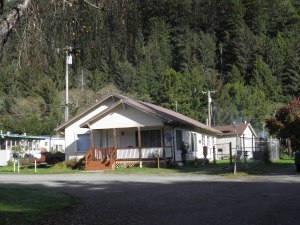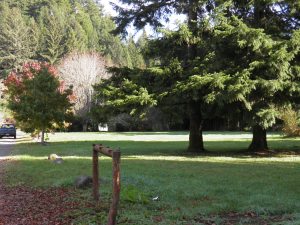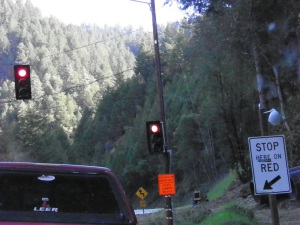Yesterday, I drove south from Crescent City along Highway 101 to Arcata, then took Highway 299 east to Redding, then Highway 44 east to Lassen County. It was a beautiful day for travel. I wish I’d had time to stop and take more pictures.
I took this particular route home because I wanted to stop in Klamath, just 20 miles south of Crescent City, and see my dad. I took him some crab, and I showed him the pictures I’d taken of Scholls. I had loaded them on my laptop, so they were large enough for him to see. To my delight, he too recognized the curves of the Scholls Ferry-Sherwood Road that ran past the farm. He knew where the store should be in relation to the road that ran up to the farm, now called SW Scholls Drive, and where the bridge would be from the intersection in front of the store. He actually confirmed my belief that I found the farm.
To say I was surprised is an understatement. I thought he would pooh-pooh and tut-tut and tell me that there was no way to be sure. And he didn’t do that. He seemed pleased that I’d found the place, and pleased to see the pictures, and pleased to talk about it. It helped that he was sober and glad to see me, although an hour’s visit is about all he can handle. After that, you’re just cutting into his TV time.
I asked him when he thought the Sanders’, Dora and Maynard, who owned the farm and were also our landlords in Klamath, sold the farm. He said he thought they sold it two or three years later, after we moved back to Klamath late in the fall of 1963. We actually lived on the farm less than a full year, although my brother and I went to part of two grades of school at Groner Elementary in the spring and fall of 1963. Dad said that Maynard and Dora were never able to make a success of the farm, although he thought they might have leased the farmland out to other farmers for a few seasons. They had to sell it after a couple of years, and that might have been when the seed and feed business that’s there now went in, and eventually, the other homes. Dad says the little white farm house and the barn were old when we lived there, so it didn’t surprise him that the buildings had been torn down and that other buildings had been put up in their place.
When we moved back to Klamath, we didn’t at first move back to what was then called Sanders’ Court. Dora and Maynard owned several acres of land with a bunch of shacky little houses on them. Their house was a big, beautiful, Colonial-style farm house with a veranda that ran all the way around the house, and Dora had a huge vegetable and dahlia garden west of their house that you could see from the highway. We had lived in a duplex at the end of Sanders’ Road, on the north side of the road. The duplexes were originally built with two bedrooms and one bathroom.
When we first moved back to Klamath in late 1963, the duplex in Sanders’ Court we’d lived in since I was two was occupied by other renters. We moved into another duplex right across the highway in a group of small rentals owned by some people named Sage, so it was known as Sage’s. We lived there for a couple of years, I believe, maybe until 1965. I know we lived at Sage’s during the tsunami that hit Crescent City in 1964 and the great Christmas flood of 1964. We had gone to visit relatives in Oklahoma for Christmas that year and couldn’t get home for several weeks because there were no bridges left between Sacramento and the California-Oregon state line. We stayed with relatives in Winters, California, waiting for temporary bridges to be built, and I went to school for a month at the elementary school there.
When the renters who lived in “our” house at Sanders’ Court moved out around 1965, we moved back into it. My parents had a long friendship with Dora and Maynard, and Maynard was getting older by this time. Dad helped him out around the place with repairs, like tarring roofs, in exchange for reduced rent, and when I was about 12, Dad built a third bedroom and bathroom onto the back of our side of the duplex. That was mine and my sister’s room. We had our own woodstove in our bedroom because it was so far from the woodstove in the living room. And still sometimes I would get so cold, I had up to ten quilts on my bed in the winter. I was a scrawny kid, just skin and bones at that time because I’d been through spinal fusion surgery for scoliosis and had been in a body cast for 10 months. Our neighbors on the other side of the duplex at that time were the Darbys. Tom Darby has done a lot of writing about his years as a kid in Klamath, and his book is called “Growing Up Klamath.” It can be found on Amazon and as an e-book.
When I was 16, Sanders’ Court got to be too much for Dora and Maynard to handle. They sold off the north side of it, our side, to a couple named Pritner. Mr. Pritner was a mean old son-of-a-gun. He decided he wanted to live in “our” house because it now had three bedrooms and two bathrooms, so he served an eviction notice. My parents decided it was time to buy their own house, if they could find the money, so they borrowed $9,000 from my mother’s sister and bought a two-bedroom, one-bath house with an attached shop on Lonesome Road. My dad added onto the house and still lives there today.
As I was getting ready to leave Dad’s yesterday and head for home, I asked him if the duplexes in Sanders’ Court were still there. It had been several years since I’d been down that road, and at that time, the houses were still standing, although I don’t think anyone lived in them.
“No,” Dad said. “They’re gone. Most of the houses in there are gone now. After Pritner died, somebody else bought it, and I don’t know the man, don’t even know his name.” I asked if he thought it would be okay if I went down there to take a look and snap a few pictures. “Oh, sure,” Dad said. “It’s not posted as a private road.”
So I gave my dad a big hug, told him I loved him, and headed off down the road to find another piece of my childhood.
As I drove up Sanders’ Road, I noticed how different it looked, but still recognizable. The house on the corner of the frontage strip owned by the Fortaines where my aunt and uncle and cousins lived for some years was still there.
I could see where Dora’s garden and the Sanders’ house had been.
And at the end of the road, there was the foundation for our duplex. A pile of boards lay nearby, and a pile of scrap and brush was smoldering. There were two men tending the fire. I called out a greeting, and one of them came over to speak to me.
He was the owner of the property now. I told him that I’d lived there for many years as a kid, and asked him if I could take some pictures. He didn’t mind at all and was happy to talk to me about the changes that had taken place over the years since he’d bought the property. He’s had it 27 years, so he must have bought it just after Dennis and I and our family left Klamath for Lassen County.
He said, “I cloned a lot of these young redwoods you see in here and planted them years ago. Now my wife is making me cut a lot of them down because they’re shading the place too much. And I planted all the Japanese maples you see along the road.”
He told me that the Sanders’ house had burned down, and it had sure made him sad. “There was a lot of redwood in that house,” he said.
I told him that I’d lived in the duplex on the right. “That one had three bedrooms and two bathrooms,” he said.
I said, “Yes, my dad built on that back bedroom and bathroom.”
“That room had a lot of redwood in it too,” he said. “I saved all the redwood two-by-four framing, all I could.” I was so glad to hear that, and I told him so.
As we were chatting and looking around, I gave him my card and my name, and he told me his name, Alfred, only he goes by Al. He also gave me his last name, but it went right out of my head by the time I’d gotten back in the car. Al asked me if the old cabin was here when I lived here. I was really surprised that it was still standing, because it was old when I was a little girl. A family by the name of Beaver lived in it then. Al told me that it was the oldest house in the whole area, and that it had once been across the slough where the Methodist church sits now. When they decided to build the church, Al said, the cabin was moved to Sanders’ Court. That must have happened before my time, because I always remember it being there. The fact that it is still standing is a testament to old time building skills and good redwood lumber.
Al has plans for Sanders’ Court, but it’s slow-going, working by himself most of the time. He’s also been remodeling his house up on Requa Hill.
When he mentioned living on Requa, we got to talking about who we knew in Klamath, and it turned out that he was neighbors and friends with our dear friends, the Fortinos, who recently sold their home up on Requa Hill and moved away from Klamath.
“Karen and Louie call me ‘Alfredo’” he said with a grin. “My wife and I just went to see them in their new place not long ago.”
And so, once again, I prove to myself that the corner of the world I live in is a very small place, and that there are friends to be found almost everywhere if you’re just willing to talk to people. Alfredo sent me on my way with a Japanese maple in a pot. I’ve been wanting one for the yard, and it will serve to remind me of Alfredo and Sanders’ Court, of my childhood in Klamath, and of learning in my adulthood to grow bolder instead of older.
I headed off down the coast at about 12:30, so I knew I wouldn’t get home before dark, but at least I’d be in familiar territory.
I love driving along the coast and into the mountains, along those mighty rivers, but you do have to be careful. On the coast, Highway 101 keeps trying to fall off into the ocean. It has, a time or two, in my lifetime, right along here.
On Highway 299 into the interior, the mountains keep trying to cover up the road in big slides. It seems like every year there’s a repair project going on. This year, the highway is down to one lane near Salyer, where a huge rock slide came down. I wish I’d had a place to pull off and get a picture of what the engineers and workers were doing to that bluff, but the river is on the other side of the road. There was a guy hanging in rock-climbing harness on the bluff above the slide, trying to secure something, maybe one of those big chain-link nets, into the rock. Traffic through the area is controlled, one direction at a time, by a stoplight.
And of course, there are curves. Mile upon mile of curves. Anybody who drives along the coast of California, or into the interior of the state through the mountains, had better be familiar with curves. Fortunately, having lived on the coast and in the mountains all my life, I am familiar with curves. I know how to drive on curvy roads. There’s a grace to it. You brake into the curve and accelerate out of it, letting the centrifugal force draw you around the banked curve, if the road has been engineered properly. There’s a point where you feel the vehicle in perfect balance with the road and the curve. And if the road wriggles and writhes, like Highway 299 down from Buckhorn Summit between Weaverville and Redding, you can develop a rhythm. You can dance with the road.
Of course, it helps if there aren’t any timid or inexperienced drivers ahead of you, standing on their brakes all the way down the mountain. But if you just back off, give them room, and don’t crowd them, you can still find the rhythm. Driving in these conditions requires alertness and awareness that anything can happen at any time. But the dance is fun.
And it reminds me that I can enjoy the curves ahead in my life. Just use what I know, what I’ve learned, be aware, be alert, be bold, have fun, and I can handle whatever’s around that next curve. In a way, that’s what this whole trip has been about. It’s been a dialogue with myself. Can I handle what’s around the curves? Will I stand on my brakes all the way down the mountain or dance with the road? What’s it going to be?
I’m going to dance.



















I live in Reno. My name is Kay. Tom Darby and I have known each other for 19 years. We met when he was my driver for Citilift. He’s my best friend and has taken me to Klamath and Crescent City to see his old stomping grounds. Yep, the pictures and story are spot on. So glad you are willing to talk to people. You sound like my kind of people — TALK, TALK, TALK!
Thanks, Kay. I’m glad you enjoyed it. Yes, I like talking to people. I love stories!
Thank you Jeanie. You brought a tear to this old man’s eye. Love ya!
Glad you enjoyed it, Tommy. We’re going to have to get together soon and visit.